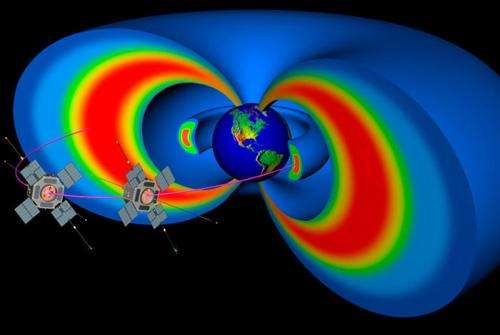Observations and simulations improve space weather models

(Phys.org) —Los Alamos researchers and collaborators used data from NASA's Van Allen Probes to demonstrate an improved computer model to help forecast what is happening in the radiation environment of near-Earth space—a place seething with fast-moving particles and a space weather system that varies in response to incoming energy and particles from the sun, potentially threatening satellites that orbit there. The work was published in a pair of articles in a special section on early results from the Van Allen probes in the Geophysical Research Letters.
NASA's Van Allen Probes regularly transit two giant radiation belts that surround Earth. Their observations of the ever-changing conditions in the belts provide real-time measurements that aid scientists' understanding of the magnetosphere and help improve computer simulations of the space weather that can affect vital technology, communication and navigation systems.
Stormy weather in the magnetosphere is a complex interplay of particles and energy from the sun entering the magnetosphere and local processes and conditions within the magnetosphere itself. In particular, the number of high-energy electrons—ones with sufficient energy to damage orbiting electronics—can vary greatly during geomagnetic storms. Scientists cannot measure what is happening everywhere at the same time. Models provide a context to describe the whole system. Researchers used data from the Van Allen Probes to improve a three-dimensional model created by Los Alamos scientists called DREAM3D (Dynamic Radiation Environment Assimilation Model in 3 Dimensions).
LANL researchers used specific measurements from the NASA probes as input to the DREAM3D model, modified with a new description of a key process. The work demonstrated that DREAM3D accurately simulated the behavior of a complex and dynamic event in the radiation belt that was observed in October 2012.
Researchers used data from the Van Allen Probes to improve DREAM3D. Until now the model relied heavily on averaged data from CRRES, the Combined Release and Radiation Effects Satellite, which flew in the early 1990s, for validation. (LANL built the Low-Energy Magnetospheric Ion Composition Sensor that was part of the CCRES on-board instrument suite.) The team applied data from the October 2012 event to the DREAM3D model.
Journal information: Geophysical Research Letters
Provided by Los Alamos National Laboratory



















